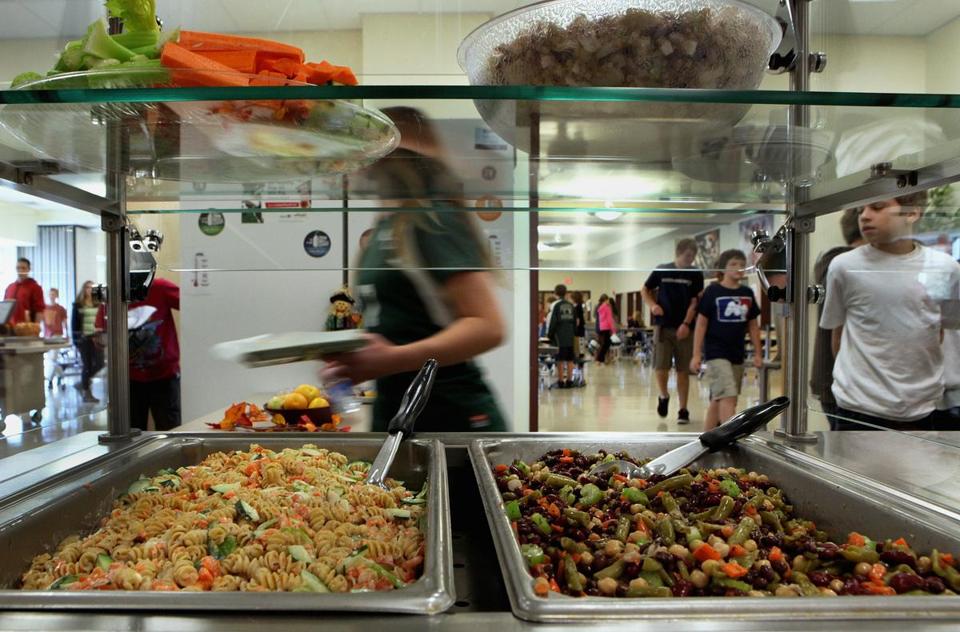by Michael Prager, for The Boston Globe
MANCHESTER – In the fight for its students’ health, the cafeteria at Manchester Essex Regional Middle High School is well situated. One row of windows looks down onto the gymnasium. The other row looks out over the “edible schoolyard,’’ 13 raised vegetable beds that educate students about nutrition and also feed them.
Every day, cafeteria staff offers eight choices, often made from scratch. Recent options included wheat-berry salad and pesto pasta made with garden kale instead of basil. Soup lovers could choose vegetable or butternut squash, served with homemade rolls – whole wheat, of course.
The move toward scratch cooking accelerated last year when nutrition director Sheila Parisien saw the direction in which federal guidelines were headed. Proposed school lunch rules, published in January, include more fruit, vegetables, and whole grains, reduced sodium, and low-fat and fat-free milk only. Regulations are expected to take effect next year. You can have all the rules you want, but if the cafeteria’s customers won’t eat, rules won’t improve nutrition. Are Manchester Essex kids buying in? Yes and no.
Sales – about 800 meals a day for the 1,500 students – are steady, at least at the Middle High School, but Donna Silva, one of four full-time food service workers, says students “aren’t crazy about the changes. The younger generation coming in doesn’t know the difference, but the kids who had the other food know the difference, and they want to know where it went.’’
Parisien and other directors say that changing menus isn’t simple. Before kale pasta appeared, for example, it was offered as a sample. Staff members go into classrooms to explain changes. “They need to know why we switched from white pasta to brown pasta, and why they should eat our burger instead of a McDonald’s burger. We did a demonstration [of relative fat content] between our burger and a Burger King burger and the Burger King burger just looked like a big Crisco sandwich,’’ she says.
Some students don’t need a lot of persuading. “Instead of trying to convince them, they’re telling us what they’d like,’’ says Parisien.
One example is the edible schoolyard. It’s led by three “green scholars,’’ including senior Simon McIntosh, 18, who is thinking about a career in sustainability. “Right now my focus is in agriculture, but I’m into all of it,’’ he says. Other students are tracking the cafeteria’s food chain, identifying highly processed products, and those with a high carbon footprint.
Typically, cafeterias rely on highly subsidized commodities and per-meal reimbursements from the US Department of Agriculture, as well as cash-register income, to keep meal prices between $2-$3. Government reimbursement is about 30 cents. For low-income students, programs receive about $2.30, and $2.78 for the poorest population. The low-income figures are so high in about 20 Boston schools, administrators can provide free breakfasts and lunches.
Partly buoyed by that reliable, if meager, funding, Boston is pressing ahead with fresh- and local-food initiatives. At one Local Lunch Thursday, the featured fresh ingredient at Dearborn Middle School in Roxbury is collard greens from Harvest Farm in Whately, prepared by manager Derric Edwards with chicken base, vinegar, a dab of oil, pepper, garlic, and chili powder. That last ingredient is spotted immediately by Boston Farm to School coordinator Kim Szeto, who is also on hand.
That day students are greeted by Sadie Richards Brown, Boston’s representative from FoodCorps, a new national organization that links young activists to low-income school districts to help educate about agriculture and nutrition. Brown is showing off collard sprouts, which are unknown to the students. Students are surprised that the chopped broad leaves on their plates had such small beginnings.
Boston schools started buying local produce in 2008; what began as a monthly effort in six schools has grown to a weekly effort in the 44 schools with kitchens. Last year, three schools got salad bars; more are planned. The goal is to serve as much fresh, whole food as possible, says interim food and nutrition service director Shamil Mohammed. Besides funding, he has to change what foods schools receive. Commodities are typically processed foods, easier to ship with a longer shelf life. The industry has a reason not to change, says the director. “You’re asking them for a less processed product. That’s what their value add is, and we’re telling them, don’t put too much value in it.’’
In Boston, where dozens of schools lack cooking facilities, a generation of cafeteria workers has been practicing a common technique: heat and serve. Now schools have partnered with Project Bread and chefs such as Kirk Conrad, a graduate of the Culinary Institute of America, regularly visit to offer workers training. Cafeterias draw more students when the chefs are around.
Cambridge schools have drawing cards of their own, including a new salad bar at Morse School and a new chef and expanded cafeteria at Rindge and Latin School. Kitchen manager “chef Vin’’ Connelly is out to prove that scratch cooking can be cost-effective: “Unprocessed food is a lot cheaper,’’ he says, though it requires more labor.
The schools began scratch cooking about six years ago, says food service director Jack Mingle. But the going is slow: Districtwide, it’s generally offered three out of 20 days a month, and he finds it more expensive. “The perfect example is [local] butternut squash, says Mingle. “We used to take canned green beans almost free from the USDA. It costs us $25,000 more a year to work in the squash just once a month.’’
In addition to student tastings, Mingle likes cafeteria workers to engage students in the lunch line, using whatever selling points he can muster, such as putting newer dishes before the familiar ones. He is practically giddy about sales numbers at Rindge and Latin School, where he’s selling as many as 700 meals a day, up from about 300 last year. “The newness is bringing them in,’’ he says. He predicts that the food will keep them there.
Student Sarah Eustache, 16, says she goes most days. She likes the atmosphere and the food is better, she says, “actual lunches instead of just sandwiches.’’
Challenges remain. The enthusiastic Eustache gives her assessment across Cambridge Street from the school, where she is chowing on a chicken panini from Harvard Market.



